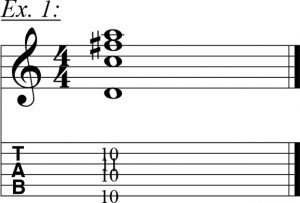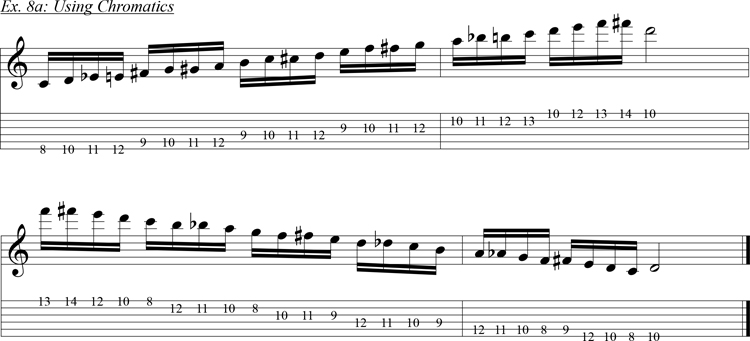So here’s a D7 chord. No. Not all the inversions. Just this one for now.

Here’s an arpeggio fingering that goes with it.

Now, here’s the D mixolydian scale. It’s commonly used as a companion scale for soloing over D7. Yes. There are certainly way more options. But this works pretty well.

Cool. Now we got a little flow going. Here’s a D7 pentatonic I like to use sometimes. You can think of it in at least two ways: 1) D minor pentatonic with major 3rd. 2) D7 arpeggio with 4th degree (G) added.

The basic idea is this: “Take what you already know, and find a different angle on it.” I find that when I do that, I can come up with way more things than if I “just wait to be inspired.” Of course, I have to be willing to wade through a bunch of bad ideas, but the good ones are always buried in there somewhere. I just need to keep looking. Let’s keep going and see where it takes us. Here’s a D7 arpeggio with the 2nd degree (E) added. You may want to call this a D9 arpeggio. That’s fine too, but to me the 9th implies an octave displacement.

Here’s another way to play the exact same thing. This one will “feel” kinda like an A minor pentatonic, but with F# replacing G.

This next one is tricky to think about, but sounds really cool. Because you never play the root of the chord, every note sounds like it “could” go someplace else. The root always works, but it has a way of conveying “I’m home now. There’s no place left to go.” It’s based on F# minor pentatonic with b5. F# is the 3rd of D7. The b5 of F# is C; which is the b7 of the D7 chord. Verbally, this sounds much more confusing than it really is. Play it and see:

This version of D mixolydian pentatonic #3 probably “looks” more like F# minor pentatonic b5. It might illustrate the idea a little better:

Let’s mess with it a bit more. Here’s a D9 arpeggio. Notice that the 9th of the chord is played before you begin the next octave. Because of this the phrase “doubles back.”

This is a variation where the 13th (B) is added:

So what else? How about chromatics? Ok, sounds good. I like talking to myself. This example is all the chromatic pitches I could find (using my ear to decide what I like/don’t like). This is what I came up with.

Here’s another one using roughly the same concept. But here, there are some twists and turns. These were created by ordering the pitches a little differently. For the ascending part, the 4th degree (G) is played before the 3rd (F#). Descending, the b3 (F) is played before the 3rd (F#), and the b5 (Ab) is played before the 5 (A). Get the idea?

No. It’s not really “All about D7” or “Everything I know about D7.” Rather, these are more like “seeds.” Most of these start and/or end on the 6th string. That was done so that you can see the range of possibilities. When practicing, do these in all keys, all positions, different rhythms, different starting pitches etc. Always try new stuff!


